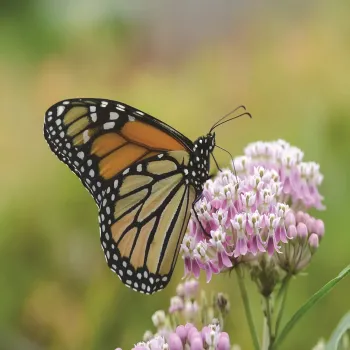Home gardeners will have noticed an obvious reduction in the bee and butterfly populations this growing season. A simple daily morning head count of butterflies and native and European bees foraging on the flowering plants in our gardens provides alarming evidence of the decline. It’s not our imaginations deceiving us.
Between June 2024 and January 2025 (just six months!) more than 60% of commercial honey bee colonies have died. The die off seems to have begun last winter when commercial beekeepers reported losses averaging around 40%. This is the largest decline ever recorded since survey collection began in 2010. Colony losses varied among states from 34.3% to 90.5%.This decline is similar but not the same as the Colony Collapse Disorder or CCD bee die-off in 2006, from which bee populations had mostly recovered by this year.
After reports of the bee deaths were released this spring, the USDA began investigating the high colony losses using RNA and DNA testing on dead bees and varroa mites from over 100 colonies. Varroa mites are external parasites that feed on bees, weaken their immune systems and transmit viruses. Nearly all the colonies that collapsed tested positive for bee viruses spread by the mites. Varroa mites are increasingly difficult to control, as they have gradually developed resistance to all of the available miticides.
Studies on the decline in populations of native bees, including bumble bees and mason bees (which are not raised commercially for their honey), are ongoing but so far numbers are not easily available. Causes for this decline in bee populations are suspected to be multiple and include miticide-resistant varroa mites, climate change, exposure to pesticides and loss of habitat and food sources

Around the same time that early reports of commercial honeybee deaths were released, a study in the March 2025 issue of Science magazine found that butterfly populations across the U.S. are also in decline. Butterfly population numbers have dropped 20% in the last 20 years. Although some butterfly species’ populations have increased, most have declined by more than 50% and a few have declined by 90%.
Many home gardeners have made a strong effort to include a wide variety of pollinator-friendly flowering plants in their gardens to provide pollen and nectar from early spring to late fall. We now need to redoubleour efforts. Unfortunately the high temperatures that prevail during the long summer season here in the Central Valley cause many plants, including drought-tolerant natives, to slow or stop flowering. A walk around our neighborhoods in July and August or a visit to the Master Gardeners' Garden of the Sun in Fresno or the Clovis Botanical Garden can help home gardeners identify those plants that can withstand the summer heat and continue blooming. One of the best lists of low-water bee plants grouped by bloom months is on the UC Davis Bee Haven website.
Always follow the general guidelines for creating or improving a pollinator-friendly garden. Thirsty bees need clear trickling water and thirsty butterflies drink from shallow puddles. Many species of bees make their nests in undisturbed soil; leave some areas in your garden unplanted and undisturbed. Pesticide use in home gardens (especially neo-nicotinoids) should be eliminated.
_____________________________
Written by UC Master Gardener Elinor Teague
Sources:
Elina L. Nino, May 24, 2016, “Deciphering the mysterious decline in honey bees”, UC Cooperative Extension via The Conversation
“U.S. Beekeeping Survey reveals highest honey bee losses during 2024-2025”, June 16, 2025, Auburn University College of Agriculture
“Scientists Discover Culprit Behind Massive Honeybee Decline in the U.S”, July 8, 2025, Gazette Review
Brian D. Inouye, March 6, 2025, “Butterfly Populations Flutter Bye”, Science (magazine), Vol. 387, Issue 6738


